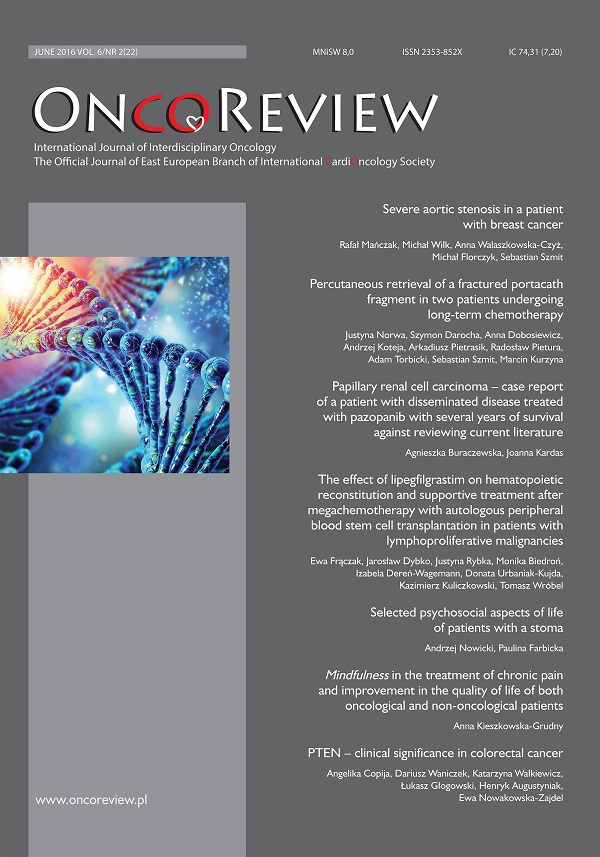Selected psychosocial aspects of life of patients with a stoma Original article
Main Article Content
Abstract
Cancer causes huge problems, physical and mental nature mainly. In particular, we cannot forget about the functioning of these patients in the social and spiritual spheres. The increasing trend of incidence of rectal cancer makes the disease is becoming a priority for doctors, nurses and psycho-oncologists. Despite the increasing quality of medical services, patients face a number of problems associated with cancer treatment, which may result in formation of a colostomy. The procedure, which is necessary to save the patient’s life, is often perceived by them as “mutilation”. Acceptance of the disease and satisfaction of life in patients with a stoma after the operation for rectal cancer are dependent on many factors. Social support, living conditions and the time elapsed since creation of the stoma have great impact. “Stoma nurse” plays an extremely important role. Seeing the difficulties in adapting the stoma she should verify the patient’s pessimism as to his/her own self, develops a sense of responsibility from minor to major issues and strengthen a sense of independence.
Downloads
Metrics
Article Details

This work is licensed under a Creative Commons Attribution-NonCommercial 4.0 International License.
Copyright: © Medical Education sp. z o.o. This is an Open Access article distributed under the terms of the Attribution-NonCommercial 4.0 International (CC BY-NC 4.0). License (https://creativecommons.org/licenses/by-nc/4.0/), allowing third parties to copy and redistribute the material in any medium or format and to remix, transform, and build upon the material, provided the original work is properly cited and states its license.
Address reprint requests to: Medical Education, Marcin Kuźma (marcin.kuzma@mededu.pl)
References
2. Alberts S, Citrin D, Rodriguez-Bigas M. Nowotwory okrężnicy, odbytnicy i odbytu. In: Krzakowski M, Kawecki A (ed). Nowotwory złośliwe – postępowanie wielodyscyplinarne – leczenie systemowe, chirurgiczne, radioterapia. Vol 1. Czelej, Lublin 2012: 243-263.
3. Banaszkiewicz Z, Jawień A. Stomie jelitowe. Przew Lek 2003; 10: 89-92.
4. Łacko A. Rak jelita grubego. Post Nauk Med 2011; 2: 137-145.
5. Ponczek D, Rozwora A. Ocena przystosowania się do życia chorych z kolostomią. Piel Chir Angiol 2011; 3: 140-148.
6. Bujko K. Radiotherapy of advanced colorectal cancer. Contemp Oncol 2006; 10: 141-142.
7. Backes M, Backes D, Erdmann A. Feelings and expectations of permanent colostomy patients. J Nurs Educ Pract 2012; 2: 9-14.
8. Jabłońska I, Drabik U. Charakterystyka aspektów jakości życia pacjentów z rakiem odbytnicy. Probl Piel 2009; 17: 144-151.
9. Nowicki A. Pielęgniarstwo onkologiczne. Termedia, Poznań 2009: 233-254.
10. Sinha G. Colorectal cancer survivors need better follow-up care. J Natl Cancer Inst 2014; 106: 338-339.
11. Benedict C, Philip EJ, Baser RE et al. Body image and sexual function in women after treatment for anal and rectal cancer. Psychooncology 2015; 14: 3847-3848.
12. Bazaliński D, Barańska B, Cipora E. Stomia jelitowa nie musi być przyczyną niepełnosprawności. Med Rodz 2006; 3: 58-63.
13. Widera A. Psychologiczne aspekty resekcji odbytnicy. Med Prakt Chir 2010; 9: 95-100.
14. Kołodziejczak M. Opieka nad pacjentem ze stomią. Med Rodz 2006; 2: 32-36.
15. Kot A. Radzenie sobie z następstwami trwałej stomii jelitowej na przykładzie losów życiowych 2 osób. Ann UMCS, Lublin 2010; 23: 1-15.
16. Steller B. Jakość życia jako pojęcie subiektywne i wielowymiarowe. Piel Pol 2001; 12: 227-233.
17. Grumann MM, Noack EM, Hoffmann IA, Schlag PM. Comparison of quality of life in patients undergoing abdominoperineal extirpation or anterior resection for rectal cancer. Ann Surg 2001; 233: 149-156.
18. Sprangers MM, Taal BG, Aronson NK, teValde A. Quality of life in colorectal cancer. Stoma vs. nonstoma patients. Dis Colon Rectum 1995; 38: 284-290.
19. Fryc-Martyńska J. Operacja – stomia – depresja? Troska 2002; 3: 11-14.
20. Frigell A, Ottander M, Stenbeck H, Pahlman L. Quality of life of patients treated with abdominoperineal resection or anterior resection for rectal carcinoma. Ann Chir Gynaecol 1990; 79: 26-30.
21. Piwonka MA. Merino JM. A multidimensional modeling of predictors influencing the adjustment to a colostomy. J Wound Ostomy Continence – Nurs 1999; 26: 298-305.
22. Nugent KP, Daniels P, Stewart B et al. Quality of life in stoma patients. Dis Colon Rectum 1999; 42: 1569-1574.
23. Renner K, Rosen H, Novi G et al. Quality of life after surgery for rectal cancer: do we still need a permanent colostomy? Dis Colon Rectum 1999; 6: 51-53.

